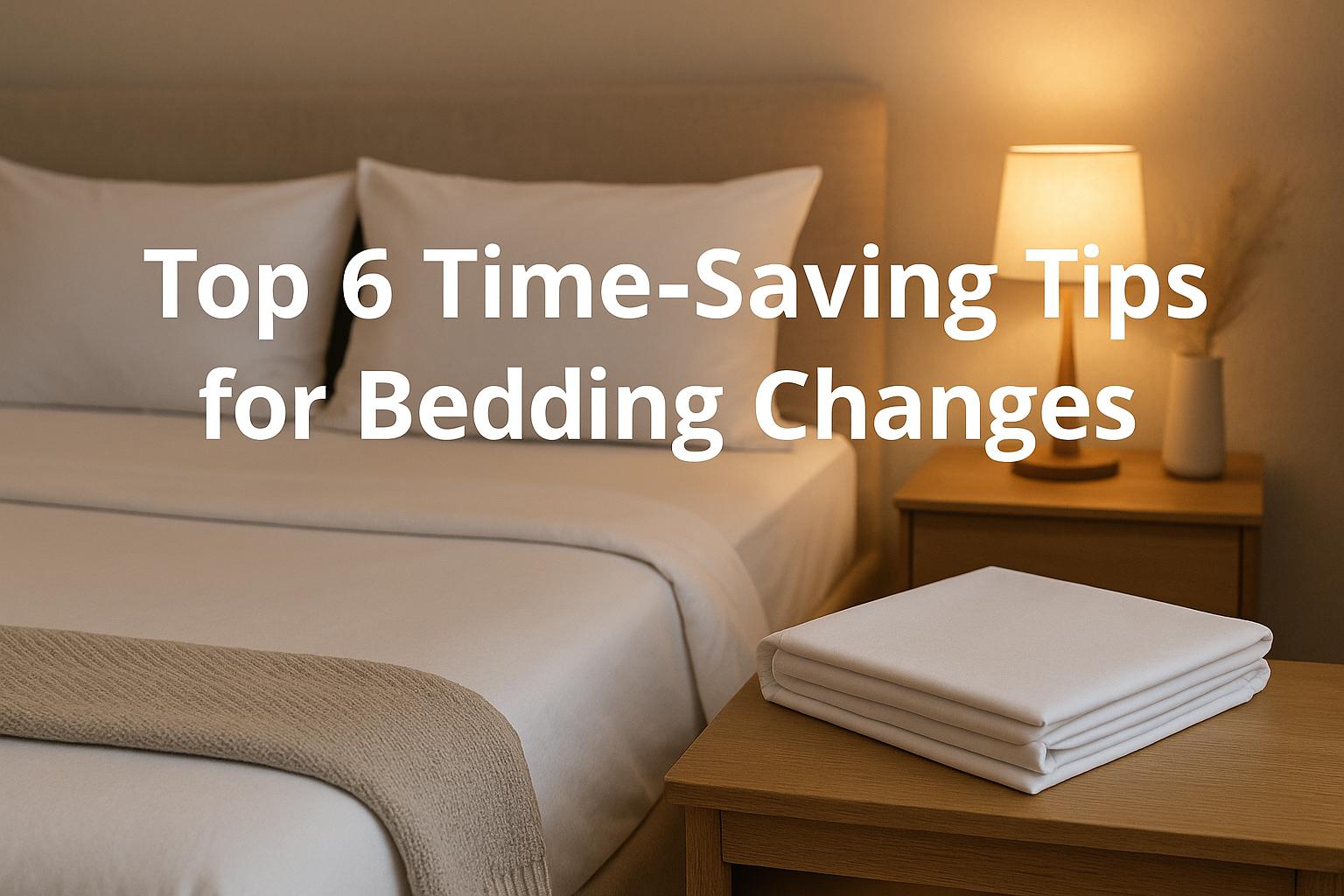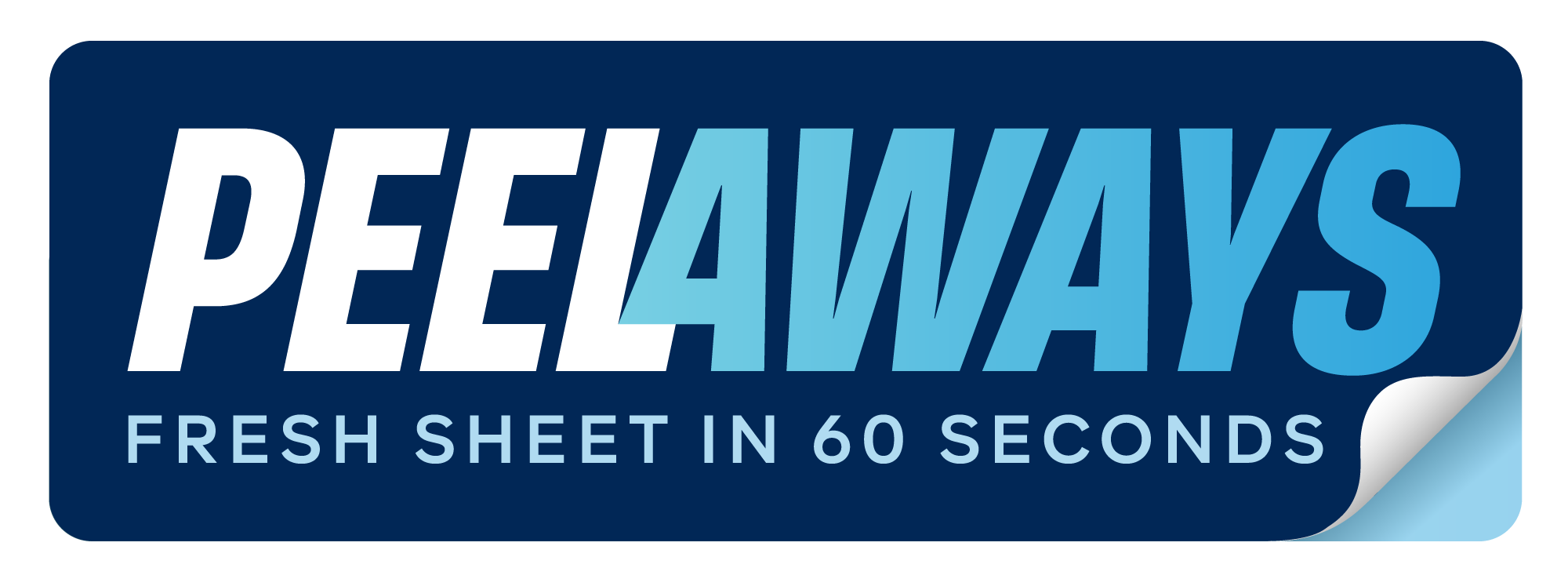Top 6 Time-Saving Tips for Bedding Changes

Changing bedding after accidents can be exhausting, but it doesn’t have to be. With these six strategies, you can save time, energy, and reduce stress:
- Multi-Layer Disposable Fitted Sheets: Peel away soiled layers in seconds for a fresh bed, cutting change time to under 2 minutes.
- Layer Bedding: Stack waterproof pads and sheets for easy removal during nighttime accidents.
- Waterproof Mattress Protectors: Protect mattresses from spills and reduce cleaning time.
- Disposable Bed Pads: Quickly swap pads without stripping the entire bed.
- Organize Supplies: Keep clean sheets, pads, and wipes within reach for faster changes.
- Quick-Change Bedding: Use easy-to-remove bedding to simplify the process.
These solutions improve efficiency and help caregivers focus on what matters most. Below is a quick comparison of key options to help you decide what works best.
How to Change the Sheets with someone in the bed - Tips for Caregivers
Quick Comparison
| Solution Type | Time Savings | Ease of Use | Upfront Cost | Long-term Cost | Best For |
|---|---|---|---|---|---|
| Multi-Layer Disposable Sheets | Excellent (30s) | Very Easy | $30.99-$53.99/pack | Moderate to High | Frequent accidents |
| Layered Bedding | Good (1-2 min) | Moderate | Varies | Low | Nighttime disruptions |
| Waterproof Mattress Protectors | Good (2-3 min) | Easy | $30-$80 | Low | Mattress protection |
| Disposable Bed Pads | Fair (1-2 min) | Easy | $20-$35/pack | Moderate | Light or temporary use |
1. Use Multi-Layer Disposable Fitted Sheets
Multi-layer disposable fitted sheets are a game-changer for caregivers managing incontinence or nighttime accidents. Unlike traditional sheets that require complete removal and replacement, these sheets come with several thin, absorbent layers stacked together. Elastic edges keep them securely in place on the mattress. When the top layer gets soiled, you simply peel it away to reveal a fresh, clean layer beneath - no heavy lifting or complicated steps required. This design makes bedding changes faster and far less stressful.
Time Savings
Switching to multi-layer disposable fitted sheets can save a surprising amount of time. While traditional bedding changes can take around 10 minutes, these disposable sheets cut that down to under 2 minutes. For instance, one caregiver shared that using these sheets for an elderly parent with nightly incontinence reduced the average bedding change time to just a couple of minutes per incident.
Now, think about how this adds up. If someone experiences multiple accidents during the night, saving 8 minutes per change can mean more sleep for the caregiver and less physical strain from repeated bed-making. The quick peel-away design also minimizes disruptions for the person in bed, helping them settle back to sleep faster. It’s a small change that makes a big difference.
Ease of Use
These sheets are designed with simplicity in mind. The elastic edges keep each layer snugly in place, and the peel-away feature is incredibly straightforward. No special skills or strength are needed - just peel off the soiled layer, and the next one is ready to go.
This ease of use makes them a lifesaver during stressful nighttime accidents. Even caregivers with limited experience or physical challenges can handle the process quickly and without frustration. The clean separation between layers ensures a smooth transition, which is especially helpful when time and patience are in short supply.
Hygiene and Cleanliness
The peel-away feature doesn’t just save time - it also promotes better hygiene. By allowing caregivers to remove soiled layers immediately, these sheets help reduce prolonged exposure to moisture and waste. This can prevent skin irritation, bedsores, and even infections.
Unlike traditional bedding, where the person might have to remain on a soiled surface while replacements are being prepared, these sheets eliminate that waiting period entirely. Each discarded layer is promptly removed from the environment, minimizing the spread of germs and creating a healthier space overall[1][2].
In incontinence care, maintaining a clean, dry surface is critical for health and comfort. Multi-layer disposable fitted sheets make it easier to achieve this standard without added hassle.
Cost-Effectiveness
At first glance, these sheets may seem more expensive, with prices ranging from $1.50 to $4.00 per sheet depending on size and brand. However, the long-term savings often outweigh the upfront cost. By reducing the need for constant laundry cycles, families save on water, detergent, and energy costs. Plus, the time saved can alleviate caregiver fatigue and stress, which is invaluable.
For families dealing with frequent accidents, the convenience and efficiency of these sheets often justify the investment. Instead of replacing entire bedding sets, you only need to peel off the soiled layer, reducing the frequency of full replacements. Over time, this can help balance the cost while providing peace of mind and better rest for everyone involved.
2. Layer Bedding Strategically
Layering bedding in a specific order can save time and minimize stress during nighttime accidents. By setting up multiple layers of sheets and waterproof pads, you can quickly remove a soiled top layer to reveal a clean one underneath. This simple tactic can transform a lengthy 10–15-minute bedding change into a quick 1–2-minute fix, making a world of difference during those late-night disruptions.
Start with a waterproof mattress protector as your base, followed by a fitted sheet, a waterproof pad, and another fitted sheet. You can repeat this layering process as needed, ensuring everything is ready for immediate use. This method pairs well with other time-saving bedding solutions, helping streamline your nightly routine.
Time Savings
Layering bedding can drastically cut down on the time needed to change sheets. One caregiver shared that using three layers - a waterproof pad and fitted sheet combination - allowed her to handle nighttime accidents quickly, helping her loved one get back to sleep without prolonged interruptions.
Ease of Use
Once the layers are in place, changing the bedding becomes a simple process. There’s no need to wrestle with heavy mattresses or struggle to fit sheets in the middle of the night. This approach is especially helpful for caregivers assisting individuals with limited mobility. Keeping extra top sheets, blankets, and nightclothes nearby can make the process even smoother.
Hygiene and Cleanliness
This layering system ensures that soiled bedding can be replaced immediately, reducing the risk of prolonged exposure to moisture or contaminants. Quickly removing the top layer helps minimize odors and prevents the spread of germs, creating a cleaner and healthier sleep environment.
Cost-Effectiveness
Although buying multiple sets of sheets and waterproof pads may seem like a larger upfront expense, this strategy can save money over time. It reduces the need for frequent full bedding washes and protects mattresses from moisture and stains, extending their lifespan. Reusable, washable waterproof pads are a more economical choice compared to disposable options. Just make sure the layers are secured properly to prevent bunching, ensuring both comfort and skin protection.
3. Use Waterproof Mattress Protectors
Adding a waterproof mattress protector to your bedding setup is a smart move to keep your mattress safe from moisture. This simple yet effective layer acts as a barrier against spills and accidents, stopping them from soaking into the mattress. It’s a practical way to protect your investment while making cleanup much easier.
Look for a protector with deep pockets and elastic edges to ensure a snug fit. Opt for materials that are not only waterproof but also breathable, soft, and quiet, so you don’t sacrifice comfort for functionality.
Time Savings
A waterproof mattress protector saves you from the hassle of deep cleaning or, worse, replacing your mattress after an accident. Without this layer, liquids can seep through your bedding, forcing you to strip everything down and wait for the mattress to dry - a process that can take hours. With a protector, cleanup is quick and limited to the sheets, keeping the mattress untouched. It works seamlessly with layered bedding systems, stopping moisture before it becomes a problem.
Ease of Use
These protectors are as easy to use as a fitted sheet. Once in place, they stay secure throughout the night and provide a smooth surface for your bedding. They’re machine washable, dry quickly, and can be reinstalled in seconds, making them a hassle-free addition to your routine.
Hygiene and Cleanliness
Waterproof protectors do more than just block moisture - they also shield your mattress from bacteria, allergens, and odors that can build up over time. By preventing moisture from reaching the mattress, they stop mold and mildew from forming, especially in humid conditions or after repeated spills.
Their non-porous surface makes sanitizing simple. Unlike mattresses, which are tough to clean thoroughly, protectors can be tossed in the washer and cleaned with hot water and disinfectants like bleach, ensuring germs and contaminants are completely removed.
Cost-Effectiveness
Priced between $30 and $80 depending on size, a waterproof mattress protector is a small investment compared to the cost of replacing a mattress, which can range from $500 to $3,000 or more. It’s a budget-friendly way to avoid expensive replacements and extend the life of your mattress.
Additionally, protectors help preserve your other bedding. By containing accidents at the protector level, your sheets and blankets endure less frequent and harsh washing, which helps them maintain their quality and appearance over time.
sbb-itb-45288fe
4. Keep Disposable Bed Pads and Underpads Ready
Adding to the earlier tips for simplifying bedding care and protecting your mattress, having a stash of disposable bed pads and underpads on hand can make a big difference in managing accidents quickly and easily.
Keep these lightweight, absorbent pads within arm’s reach to handle spills before they soak through to the primary bedding. Store them in a bedside caddy, drawer, or even a nearby closet or under-bed container to ensure they’re always accessible when needed.
Time Savings
With disposable pads at the ready, you can quickly swap out a soiled pad for a clean one without the hassle of stripping the entire bed. This not only saves time but also helps reduce interruptions, especially during the night.
Ease of Use
Disposable pads are as straightforward as it gets - just place them on top of your bedding. Thanks to their non-slip backing, they stay securely in place, making them a reliable option for caregivers juggling multiple tasks.
Hygiene and Cleanliness
These single-use pads provide a fresh surface every time, helping to maintain a clean and sanitary sleeping environment. This is especially important for reducing the risk of cross-contamination and ensuring comfortable rest.
5. Organize and Prepare Supplies in Advance
Having the right bedding and cleaning supplies ready to go can turn those hectic nighttime changes into a much smoother process. Set up a bedside station stocked with essentials like clean sheets, disposable pads, and wipes. A rolling cart or bedside caddy works perfectly for keeping these items handy, even in low light.
It’s smart to stock up ahead of time. Aim to maintain at least a two-week supply of disposable sheets, pads, and cleaning materials to avoid last-minute scrambles when accidents happen. If the person you’re caring for moves between rooms or floors, consider setting up supply stations in multiple areas of your home. This way, you’re prepared no matter where you are.
For added convenience, organize your supplies by how often you use them. Keep the most frequently needed items at eye level and within easy reach. Store backup bedding and less-used items on higher shelves or in less accessible spots. This simple system ensures you won’t waste time hunting for what you need during urgent moments.
Time Savings and Convenience
An organized setup saves you time and stress. With everything in its place, you can handle bedding changes quickly, even in the middle of the night. Pre-arranged supplies mean no fumbling around or second-guessing, making it easier for any caregiver to manage unexpected situations efficiently.
Budget-Friendly Benefits
Buying in bulk and storing supplies properly can help you take advantage of subscription savings, like a 15% discount, while also avoiding costly last-minute purchases. Having a backup supply also reduces the need for makeshift solutions, which can often lead to waste.
6. Choose Easy-Care, Quick-Change Bedding
When it comes to efficient bedding management, the right choice of bedding can make all the difference. While traditional cotton sheets require frequent washing and multiple sets for rotation, disposable bedding offers a much more streamlined solution. These options are designed to simplify the process, especially during urgent changes, while still providing comfort and practicality.
For instance, multi-layer disposable fitted sheets are a game-changer. With built-in layers, they eliminate the need to lift heavy mattresses or juggle multiple linens. Just peel away the top layer, and you're left with a fresh, clean surface in seconds.
High-quality disposable bedding combines waterproof protection with soft, breathable material, offering a level of comfort comparable to traditional cotton. This is especially important for individuals who need gentle care. Sizes range from hospital-grade Twin XL to home-friendly queen and king options, ensuring a snug fit that stays in place all night without bunching or slipping. This complements other strategies, like layered systems and waterproof protectors, to make caregiving more efficient.
Time Savings
Quick-change bedding can save significant time by eliminating the need to strip the entire bed and wash large loads of laundry. With less time spent on laundering, caregivers can focus on other important tasks.
Ease of Use
The fitted design of disposable bedding makes it incredibly user-friendly. Whether it's a family member, an overnight nurse, or a temporary caregiver, anyone can handle the process without any special training. The peel-away layers are intuitive and require no extra effort. Plus, these bedding options come in compact, multi-layer packages, which are perfect for smaller spaces like apartments or assisted living facilities.
Hygiene and Cleanliness
Disposable bedding is an excellent choice for maintaining a clean and hygienic sleep environment. Since each layer is single-use, it significantly reduces the risk of cross-contamination, which is especially crucial for individuals with weakened immune systems or those recovering from wounds. The integrated waterproof barrier also ensures that moisture never reaches the mattress, keeping it clean and protected throughout the night.
Cost-Effectiveness
Although disposable bedding may seem more expensive upfront, it can save money in the long run by reducing laundry costs and preventing mattress damage. For example, PeelAways offers a queen-size 5-layer sheet for $47.99, averaging about $9.60 per change. Subscription options with a 15% discount make these products even more budget-friendly, making them a practical solution for ongoing care needs.
Bedding Solutions Comparison
The table below lays out a side-by-side comparison of key bedding solutions. Choosing the right option can save time, reduce costs, and ease the stress of frequent bedding changes.
| Solution Type | Time Savings | Ease of Use | Upfront Cost | Long-term Cost | Comfort Level | Best For |
|---|---|---|---|---|---|---|
| Multi-Layer Disposable Sheets | Excellent (30 seconds per change) | Very Easy | $30.99-$53.99 per pack | Moderate to High | High | Frequent accidents, multiple caregivers |
| Reusable Waterproof Protectors | Good (2-3 minutes per change) | Moderate | $15-$40 per protector | Low | Moderate | Occasional accidents, budget-conscious |
| Disposable Underpads | Fair (1-2 minutes per change) | Easy | $20-$35 per pack | Moderate | Low to Moderate | Light protection, temporary use |
| Traditional Cotton + Protector | Poor (5-10 minutes per change) | Difficult | $25-$60 initial | Low | High | Rare accidents, comfort priority |
Multi-layer disposable sheets are the quickest to change - just 30 seconds per swap. A queen-size 5-layer pack priced at $47.99 provides five full changes, averaging $9.60 per use. While they come with a higher upfront cost, the time saved and elimination of laundry expenses make them a practical choice for busy caregivers. Subscription options with a 15% discount can further reduce costs, making them ideal for families managing daily bedding changes.
Reusable waterproof protectors take 2–3 minutes to change due to the need for washing and replacement. However, they are a budget-friendly option for occasional use. With proper care, they can last for months, offering a good balance between cost and durability.
Disposable underpads are a quick and simple solution for light protection. They’re easy to replace but don’t cover the entire bed, which can leave areas exposed. They work best for temporary needs or light accidents but may shift during sleep.
Traditional cotton sheets with protectors prioritize comfort but require the most effort. Changing them can take 5–10 minutes, and the added laundry load can be significant. This option is best suited for situations where accidents are rare, and comfort is the main priority.
For families managing frequent changes, multi-layer disposable sheets stand out for their convenience and time-saving benefits. While they may cost more upfront, the reduction in laundry and caregiver fatigue often makes them worth the investment.
Conclusion
Frequent bedding changes don’t have to feel overwhelming or time-consuming. By incorporating these six practical strategies, caregivers can ease the physical and emotional demands of the task while ensuring comfort and safety for those they care for [3][4][5].
Using multi-layer disposable sheets, pairing them with waterproof protectors, and keeping supplies well-organized can make bedding changes quicker and less stressful. These small adjustments can simplify your routine significantly.
Clean, fresh bedding not only supports better sleep but also creates a more welcoming and comfortable environment [6].
When bedding changes are streamlined, caregivers can conserve energy, reduce stress, and focus more on their own well-being and the quality of care they provide [3]. A caregiving routine that works efficiently allows for a more balanced and manageable experience [3][4][5].
Start with one or two of these ideas - whether it’s reorganizing your supplies, adding waterproof protectors, or trying disposable options. Each step you take helps create a smoother routine, giving you more time for meaningful moments with your loved one and for yourself.
FAQs
What are the cost and convenience differences between multi-layer disposable fitted sheets and traditional cotton sheets?
Multi-layer disposable fitted sheets are priced between $1.50 and $4.00+ per sheet, making them more costly per use compared to traditional cotton sheets, which typically range from $40 to $80 per set and can endure hundreds of washes. Despite the higher per-use expense, disposable sheets offer a level of convenience that traditional sheets can't match - there’s no need for washing, drying, or ongoing upkeep.
This convenience makes them a practical option, especially for caregivers or medical environments where hygiene and time efficiency are top priorities. While the long-term costs may be higher, the time saved and the added focus on cleanliness often make disposable sheets a worthwhile choice for those in caregiving roles.
How can I organize and store bedding supplies to make changes faster and easier?
To make changing bedding less of a hassle, start by keeping everything organized and within reach. A handy trick is to fold matching sheet sets and tuck them inside one of the pillowcases from the set - this keeps everything together and easy to grab. For larger items like comforters or seasonal bedding, vacuum-sealed storage bags are a great way to save space and keep them dust-free.
Store essentials like waterproof mattress protectors, disposable bed pads, and extra sheets in a dedicated, accessible spot. This ensures you're always ready for quick changes, which can be especially helpful in caregiving situations. These small adjustments can make a big difference in saving time and reducing stress.
How do waterproof mattress protectors help keep mattresses clean and last longer?
Waterproof mattress protectors are essential for keeping your mattress clean and prolonging its lifespan. Acting as a shield, they guard against spills, moisture, and bodily fluids, ensuring your mattress stays dry and free from stains or odors.
These protectors also block allergens, dust mites, and bacteria, which can help lower the chances of allergic reactions and promote better sleep hygiene. On top of that, they reduce everyday wear and tear, helping your mattress remain in top shape for years.
Related posts
Comments
0

SAVE MONEY & WATER
Professionals & Institutions save a fortune on labor/laundry.

SUPERIOR COMFORT
The first thing our customers notice is how soft our sheets are.

100% WATERPROOF
Each layer is 100% Waterproof, perfect for spills and accidents

SAVE TIME
Change the sheet in under 1 minute without stripping the bed.




Leave a comment